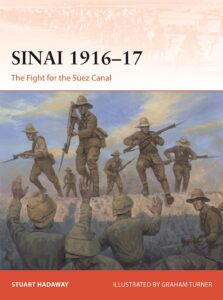Stuart Hadaway, Sinai 1916-17 (Osprey, 2025)
The most popular description of World War I reflects the European Western Front of ‘mud and blood’ in the trenches. But that is far from the whole story, as Stuart Hadaway narrates in this illuminating Campaign series book from Osprey. The theatre Hadaway is interested in is the desert campaign fought between the Commonwealth forces and the Ottomans for control of the Suez Canal, the ‘jugular vein of the British Empire’.
After retelling the background story of the Ottoman attack on the Suez Canal in January 1915, which was repulsed by the Indian garrison, Hadaway introduces the Egyptian Expeditionary Force, made up of British and Commonwealth troops, tasked with developing a buffer zone in the Sinai for the Canal. Hadaway considers the opposing commanders: the Ottoman Ahmed Djemal Pasha and General von Kressenstein, his German staff officer, and for the Commonwealth forces, Sir Archibald Murray, Sir Herbert Lawrence, and Sir Harry Chauvel. Assessing the forces follows. The Ottoman organisation changed under the exigencies of war, and the mostly peasant army faced manpower and logistical problems. They were assisted by specialised troops from their European allies. Hadaway notes the esprit-de-corps of the British and Commonwealth forces, the usefulness of their cavalry across great distances, and the lack of potency in the air, and he makes a special mention of the Egyptian Labour Corps without whom the army would have difficulty advancing or supplying itself. As for strategies, ultimately the Ottomans wanted to liberate Egypt, but they needed to control the Sinai. They ended up doing neither. The British needed to defend the Suez Canal, but initial victories led them to underestimate the Ottomans; a story that Hadaway goes on to narrate.
You cannot fight effectively in the desert without proper logistical support, and that is where Hadaway begins his narrative. He compares the British and Ottoman supply difficulties, the focus of which would be the Suez Canal. The Ottomans struck first, at Qatia, on 23 April 1916, leading to the Commonwealth forces digging in at Romani. The Ottomans attacked again in early August. After hard and often confusing fighting, the Ottomans retreated with the Commonwealth forces in pursuit. They in turn would find themselves blocked at Bir El Mazar in mid-September. Nevertheless, the advance continued. Haddaway follows the action to El Arish and Magdhaba, which fell in December 1916. By early 1917, the Commonwealth forces had achieved their strategic goal of securing the Suez Canal. Although severe setbacks awaited, Hadaway concludes here; the Sinai campaign was over.
The Sinai campaign of 1916 and 1917 may be less well known among casual readers of World War I, but Hadaway’s book should bring it to a wider audience. It is not easy to clearly narrate military campaigns fought in a desert, but Haddaway manages it very well by blending operational information with the human factor. He also weights his narrative effectively, giving due credit to the considerable work ‘behind the scenes’ in addition to the front-line fighting. With the assistance of Osprey’s customary excellent maps and illustrations, Hadaway’s book should turn more attention to this oft ignored World War I theatre.
